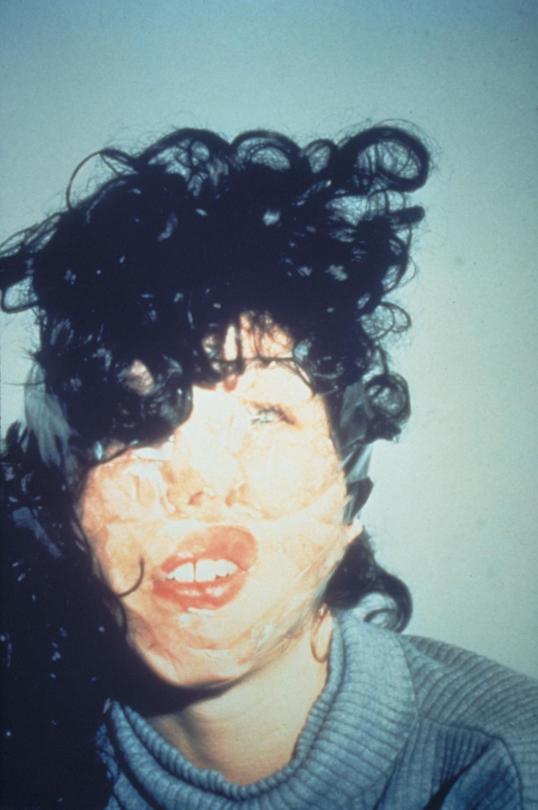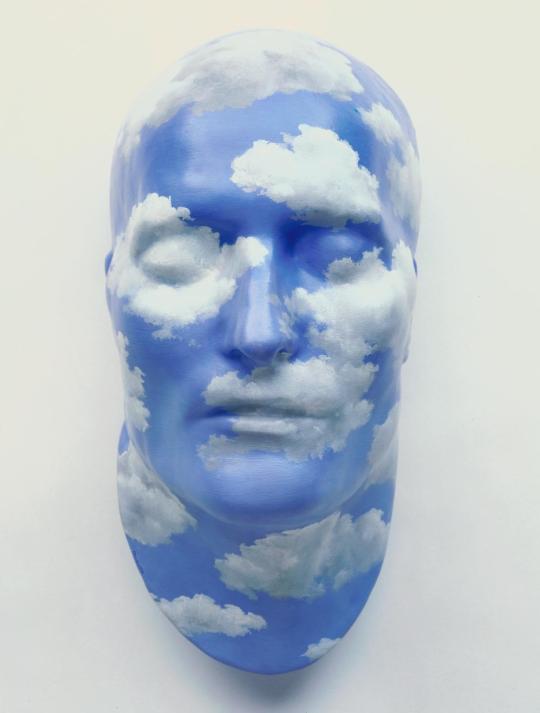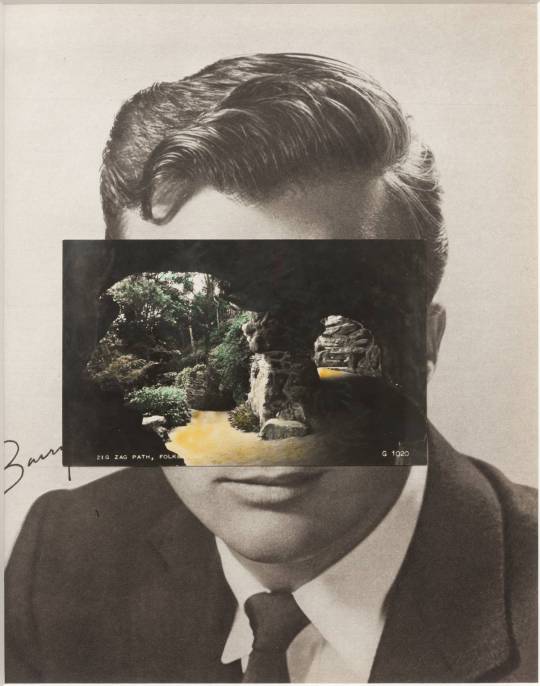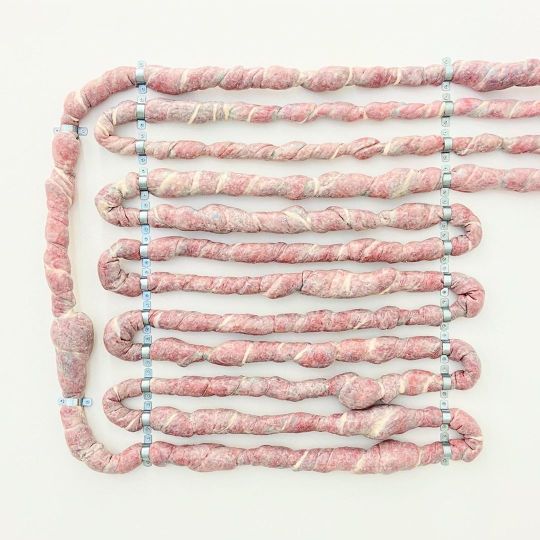Don't wanna be here? Send us removal request.
Photo








Mask art research
1. Gillian Wearing, Confess All On Video. Don’t Worry You Will Be in Disguise. Intrigued? Call Gillian Version II, 1994
Confess All On Video. Don’t Worry You Will Be in Disguise. Intrigued? Call Gillian Version II is a colour video lasting slightly under thirty-six minutes that features ten scenes, each showing a disguised person telling a secret in an unedited monologue. All of the speakers are depicted from the shoulders upwards and are heavily lit, so that their strong shadow is projected onto a white wall behind them. In some cases they gaze directly at the camera, while in others they look away. The individuals’ disguises vary in character – some entirely cover their faces with masks, while others wear wigs and other accoutrements, such as sunglasses and a fake beard, but leave their faces wholly or partly visible. The costume elements look cheap and somewhat exaggerated, with the wigs generally being large and the masks sometimes appearing cartoon-like. The confessions vary in length and content and have loose structures, suggestive of improvisation. All relate to sexual acts, crimes or acts of revenge: for example, two speakers discuss experiences of sleeping with prostitutes and one talks about stealing a computer from a school. The voice of an interviewer is heard just once during the work, asking one of the speakers their age.
This is the second version of a work of the same name that was originally produced by the British artist Gillian Wearing in London in 1994. Wearing began the project by placing an advertisement in the magazine Time Out that contained the text that makes up its title (minus the appended ‘Version II’). When respondents met Wearing, she supplied them with a range of costume elements, allowing them to construct a disguise. She then filmed them relating a secret in whatever way they chose. Originally shot in Betacam format, the video was edited and then transferred onto VHS tape. In 1997 Wearing re-edited the work to produce this second version, partly because the sound had deteriorated during the transfer to VHS and partly because during the initial edit she had cut down two of the confessions and she subsequently decided to feature them all at full length, with the result being that the second version is approximately six minutes longer than the first. This later version is considered ‘unique’ in that it was not released as part of an edition, and Tate also owns one copy of the 1994 original, which was produced in an edition of ten. When exhibited, the work must be shown on a television monitor in a relatively small space measuring approximately 3 x 3 metres, with some form of seating provided, preferably a sofa.
The title of this work primarily makes reference to the advertisement Wearing used to attract participants, emphasising the fact that the speakers actively chose to contact the artist and appear in her video.
The curator Russell Ferguson has argued that this work simultaneously involves an ‘uncomfortable’ level of intimacy and a feeling that ‘we have heard nothing we can be sure of’, since the speakers could be performing for the camera or simply lying (Russell Ferguson, ‘Show Your Emotions’, in De Salvo, Wearing, Ferguson and others 1999, p.36). Regarding the possibility that the speakers might somehow be performing in this work, Wearing stated in 1997 that ‘I noticed that they had taken time to mull over what they were going to say. One or two actually brought pieces of paper to prompt themselves. Things were set up, and it was ... ambiguous – that is where the art or the fiction came in’ (Wearing in Turner 1998, accessed 2 June 2015).
Further reading Grady T. Turner, ‘Gillian Wearing’, Bomb, no.63, Spring 1998, http://bombmagazine.org/article/2129/gillian-wearing, accessed 2 June 2015.
2., 3., 4., 5. Cindy Sherman, Untitled A, B, C, D, 1975
Untitled A, B, C and D belong to a more extensive series of photographs Sherman made while she was studying art at the State University College at Buffalo, New York (1972-6). She selected five images from the series and arbitrarily labelled them A to E. They were enlarged and reprinted in editions of ten. Sherman has explained the origins of this Untitled series:
These images were from a series of head shots that I made to show the process of turning one character into another. At that time I was merely interested in the use of make-up on a face as paint used on a blank canvas. I was experimenting with several types of characters – i.e. starting with an old person who then gradually became a drag queen. While the original series showed the entire process (about fifty 3” x 5” photos), later I chose a smaller group to make into slightly larger separate pieces. I unintentionally shot them with a very narrow depth of field, leaving only certain parts of the face in focus, which gives some of the features [a] malleable quality.
(Quoted in Contemporary Art, p.98.)
Sherman initially studied painting at Buffalo, making self-portraits and realistic copies of images she found in magazines and photographs. She began using photography after being introduced to Conceptual art by a teacher who inspired her to bring her childhood activities and obsessions into her work. She has said that as a child she was introverted, adding that ‘as a girl I used to always enjoy dressing up and being made-up. A lot of girls might like to look like their moms, but I would try to look like a monster or an old lady. Maybe I could have been an actress.’ (Quoted in Paul Taylor, ‘Cindy Sherman’, Flash Art, no.124, Oct. – Nov. 1985, p.78.) In this series of images Sherman combined painting (on her face) with photographic portraiture, assuming the personae of three female characters of different ages and one male. Variations in hairstyle and the use of hats in two of the photographs are the only props used. Below the chin the artist is bare. Two pale lines running down from either side of her neck, the result of being in the sun in a halterneck top, are clearly visible in each image and emphasise the theatricality of the work. The character in Untitled A wears a crocheted hat and has the most obvious make-up. Her dark eye-liner and lipstick, accompanied by heavy rouge just under her cheekbones to thin her face, suggest a woman in her thirties. Her submissive smile and the angle at which her head is tilted convey the sense of someone shy and anxious to please. The character in Untitled B, who is male, has joined-up eyebrows, and darkening under his eyes and chin and between his nose and mouth. For this image Sherman wore a cloth cap and pulled her chin into her neck to give the character a genial, comic air. The character in Untitled C has the least facial darkening. Her makeup mainly consists of thick mascara on her eyelashes, contributing to the wide-eyed innocent look she aims at the viewer from under her fringe. She appears only marginally older than the character in Untitled D, whose hair is held back with a pair of butterfly grips. For this pose Sherman darkened her face between the eyes, under the chin and in a line between her nose and the edges of her mouth. In all the images, Sherman has combined evident staging with the successful portrayal of a character type. This was later to become the artist’s signature technique, permitting her to evoke a wide range of emotional and thematic registers. Bus Riders 1976 is a series of photographs Sherman made shortly after leaving college, before she moved to New York and made her famous series of Untitled Film Stills 1977-80.
6. René Magritte, The Future of Statues, 1937
This work is made from a plaster copy of the death mask of the French Emperor Napoleon. A death mask is made by placing a mixture of plaster or wax over a person's face once they have died to create a mould. Magritte painted at least five of these casts, each with sky and clouds. The artist’s friend the surrealist poet Paul Nougé suggested an association between death, dreams and the depth of the sky. He commented: ‘a patch of sky traversed by clouds and dreams [can] transfigure the very face of death in a totally unexpected way’.
7., 8. John Stezaker, Mask XIII and Mask XIV, 2006
Mask XIII is a collage created by superimposing a postcard on a black and white photograph. The photograph is a film publicity portrait of an unidentifiable actress taken during the 1940s or 1950s. The postcard is a colour print mounted upside down over the actress’s face. It shows an image of a ruined stone building partially surrounded by trees. Stezaker has positioned it so that the inverted building appears framed within the actress’s face: the edge of the building matches the actress’s hairline at the right side of her face and a tree trunk and branches continuing the line of her face’s left side. Dark areas of foliage either side of the building align with her dark hair. A second tree in front of the ruin extends down the image to connect with the woman’s hand which is raised to her chin emerging from a narrow section of sky at the top of the postcard. At the bottom of the postcard, which traverses the subject’s forehead, the inverted caption ‘Nîmes – Le Temple de Diane’ identifies the ruin as the temple of Diana at Nîmes in France. The form of the inverted temple and its positioning over the woman’s face have the effect of evoking a skull: three rounded arches leading into darker spaces suggesting eye and nose-sockets and the broken upper edge of the ruin drawing the line of a broken and toothless jaw.
Mask XIV is a collage created by superimposing a postcard on a black and white photograph. The photograph is a film publicity portrait of an unidentifiable actor taken during the 1940s or 1950s. The postcard is a colour image mounted over the actor’s face. It shows a rocky cavern in which a sandy track curves around a central pillar. On the bottom left the card is captioned ‘Zig zag path, Folkestone’. At this point it covers part of the actor’s signature on his portrait above his right shoulder. Part of his first name – ‘Barry’ – is visible on the print. The postcard photograph appears to have been taken from inside a cave or under a bridge looking out through two openings towards the light. Stezaker has positioned the card on the actor’s face so that the dark silhouette of the rocky openings and the curvature of the cavern line up with the contours of the actor’s face. This placement causes an anthropomorphic reading of the postcard image – the two openings to the light suggest eyes connected by the rocky central column which covers the actor’s face in the position of his nose. Initiated around 1980, the series of Mask collages developed from the Film Still collages, such as The Trial, The Oath and Insert. The Masks all follow a similar and deceptively simple format: a film publicity portrait of a star whose face is covered by a postcard – ostensibly a mask – which opens a window into another space, paradoxically suggesting a view behind the mask constituted by the actor’s face. Initially the postcards were images of bridges and caves which in some instances united two or more protagonists. Over the years Stezaker has extended his range of imagery to include tunnels, caverns, rock formations such as stalactites and stalagmites, railway tracks, historic ruins and monuments (as in Mask XIII, 2006), woodland clearings and paths, as well as streams, waterfalls (as in Mask XI, 2005), lakes and the sea. Stezaker began collecting film stills in 1973 but was not able to afford photographic portraits of film stars until the early 1980s when their price dropped. The first portraits the artist used were damaged or of forgotten film actors, unnamed and anonymous. He has commented:
The Masks were inspired by reading Elias Canetti’s essay on masks and unmasking in his wonderful book Crowds and Power which inspired so much of my work at this time ... I was also teaching a course on Bataille and the origins of art which focused on the mask as the origin and point of convergence of all the arts. Canetti’s idea of the mask as a covering of absence and, in its fixity, as a revelation of death, alongside my discovery of Blanchot’s Space of Literature, was an important turning point in my thinking and in my approach to my work. I usually think of the key dates being 1979 and 1980 as marking a yielding to pure image-fascination and as a release from any function societal or transgressive in the work. The Masks were a response in practice to the Canetti/Blanchot idea of the ‘death’s space’ of the image and consolidated the sense of pure fascination and the desire for ‘exile from life in the world of images’, an ideal I saw in the practice of Joseph Cornell.
(Letter to the author, 26 October 2007.)
Stezaker shares with Joseph Cornell (1903-72) the Surrealist technique of apparently irrational juxtaposition and the evocation of nostalgia through his focus on outdated imagery, collected and pondered over many years. While Stezaker’s use of film stills and publicity portraits of the 1940s and 1950s stems from his boyhood experience of encountering these images on the outside of cinemas advertising films from which he was excluded because of his youth (letter to the author, 26 October 2007), his choice of postcards tends towards the Romantic tradition of nature and the sublime. The image of the zig-zag path relates to the woodland path or holzweg, a path leading – in German folklore such as that published by the Brothers Grimm in the early years of the twentieth century – to possible danger and death. Stezaker became interested in the historical phenomenon of the holzweg through his reading of Landscape and Memory (published New York, 1995) by the British art historian, Simon Schama (born 1945). The artist’s juxtaposition and careful alignment of the postcard image with the publicity portrait create an effect related to the concept of the uncanny as described by Sigmund Freud (1856-1939) in his 1925 essay, ‘The Uncanny’. Freud analysed the feeling of the uncanny aroused most forcefully by the fantastic stories of the Romantic writer E.T.A. Hoffmann (1776-1822), in particular his tale The Sandman (first published in Nachtstücke, 1817). He relates the sense of horror experienced by the protagonist Nathaniel not only to the mechanical doll Olympia, who appears real, but more significantly to a fear of losing ones eyes which he connects to the Oedipal castration complex. In the Masks the subjects’ eyes are covered; the collage intervention substitutes blankness or holes – dark and empty or leading into other spaces – creating the disturbing sensation of seeing death beneath the features of a living being.
1 note
·
View note























